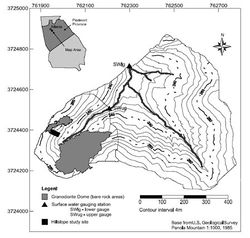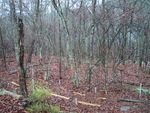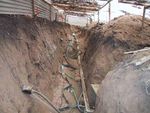Difference between revisions of "Panola Mountain Research Watershed"
| Line 74: | Line 74: | ||
*Lehmann, P., Hinz, C., McGrath, G., Tromp-van Meerveld, H.J., McDonnell, J.J. (2007): Rainfall threshold for hillslope outflow: an emergent property of flow pathway connectivity, Hydrol. Earth Syst. Sci., 11(2), 1047-1063. | *Lehmann, P., Hinz, C., McGrath, G., Tromp-van Meerveld, H.J., McDonnell, J.J. (2007): Rainfall threshold for hillslope outflow: an emergent property of flow pathway connectivity, Hydrol. Earth Syst. Sci., 11(2), 1047-1063. | ||
*McIntosh, J. McDonnell J.J., Peters N.E. (1999): Tracer and hydrometric study of preferential flow in large undisturbed soil cores from the Georgia Piedmont, USA. Hydrol. Process., 13(2), 139-155, DOI: 10.1002/(SICI)1099-1085(19990215)13:2<139::AID-HYP703>3.0.CO;2-E. | *McIntosh, J. McDonnell J.J., Peters N.E. (1999): Tracer and hydrometric study of preferential flow in large undisturbed soil cores from the Georgia Piedmont, USA. Hydrol. Process., 13(2), 139-155, DOI: 10.1002/(SICI)1099-1085(19990215)13:2<139::AID-HYP703>3.0.CO;2-E. | ||
| + | *McNamara,J.P., Tetzlaff, D., Bishop,K., Soulsby, C., Seyfried, M., Peters, N.E.,Aulenbach, B.T., Hooper, R. (2011): Storage as a Metric of Catchment Comparison, Hydrol. Process., 25, 3364–3371, DOI: 10.1002/hyp.8113. | ||
*Meerveld H.J.T.V., James A.L., McDonnell J.J., Peters, N.E. (2008): A reference data set of hillslope rainfall-runoff response, Panola Mountain Research Watershed, United States, Water Resour. Res., 44(6), W06502, DOI: 10.1029/2007WR006299. | *Meerveld H.J.T.V., James A.L., McDonnell J.J., Peters, N.E. (2008): A reference data set of hillslope rainfall-runoff response, Panola Mountain Research Watershed, United States, Water Resour. Res., 44(6), W06502, DOI: 10.1029/2007WR006299. | ||
*Peters, N.E., Freer, J., Beven, K. (2003): Modelling hydrologic responses in a small forested catchment (Panola Mountain, Georgia, USA): a comparison of the original and a new dynamic TOPMODEL, Hydrol. Process., 17(2), 345-362, DOI: 10.1002/hyp.1128. | *Peters, N.E., Freer, J., Beven, K. (2003): Modelling hydrologic responses in a small forested catchment (Panola Mountain, Georgia, USA): a comparison of the original and a new dynamic TOPMODEL, Hydrol. Process., 17(2), 345-362, DOI: 10.1002/hyp.1128. | ||
Revision as of 09:04, 29 September 2011
Location
The Panola Mountain Research Watershed (PMRW) is located within the Panola Mountain State Conservation Park, about 25 km southeast of Atlanta, Georgia, USA (84°10’W, 33°37’N).
Catchment size
- 41 ha main catchment
- 10 ha sub-catchment located in the western part of the main catchment
- 0.1 ha trenched hillslope
Climate
Humid continental to subtropical.
The mean annual precipitation is ~1240 mm, which on average is distributed uniformly throughout the year. Rainfall typically has a long duration and low intensity associated with the passage of fronts in the winter and a short duration and high intensity associated with convective rainstorms in the summer. Less than 1% of the precipitation falls as snow or sleet. A long growing season, warm temperatures, and many sunny days result in a high evapotranspiration demand, particularly during the summer. Air temperature averages 15.2°C and the average monthly temperatures range from 5.5°C in January to 25.2°C in July.
Geology
The bedrock is predominantly the Panola Granite (granodiorite composition), a biotite–oligioclase– quartz–microcline granite of Mississippian to Pennsylvanian age. The Panola granite contains pods of amphibolitic gneiss, particularly at lower elevations.
Soils are predominantly ultisols developed in colluvium and residuum, which intergrades to inceptisols developed in colluvium, recent alluvium, or in highly eroded landscape positions. Typical soil profiles on the hillslopes are typically <1.6 m thick, grading into saprolite of variable thickness. The riparian zone has the deepest soils (>5 m).
Topography
The basin relief is 56 m and slopes average 18%.
Vegetation/Land use
The watershed contains a naturally regenerated second-growth forest on abandoned agricultural land, typical of the Piedmont physiographic province. The watershed is 90% forested, dominated by hickory, oak, tulip poplar, and loblolly pine, and 10% partially vegetated (lichens and mosses) bedrock outcrops. The forested area varies from 100% deciduous to 100% coniferous.
Context of investigation
The PMRW was established in 1985 as part of the USGS Acid Rain Thrust Program. In 1991, the 41-ha forested watershed became one of five Water, Energy and Biogeochemical Budgets (WEBB) sites focusing research on the movement of water and solutes within a small forested watershed and the effects of anthropogenic and environmental change. The experimental hillslope study site was established in 1995 with the excavation of a 20-m-long trench.
Measurements/Equipment
41 ha main catchment and 10 ha subcatchment:
- Precipitation
- Climate
- Streamflow
- Several transects with recording wells
- Water quality (weekly and event sampling)
- Soil moisture
0.1 ha hillslope study site:
- Lateral subsurface flow (trench)
- Soil moisture
- Groundwater
- Sapflow (Summer of 2002)
- Sprinkling experiments (Summer of 2002 and Fall of 2006)
- Tracer experiments (Summer of 2002 and Fall of 2006)
Links to project webpages
http://ga.water.usgs.gov/projects/panola/
References
- Aulenbach, B.T. and Hoopert, R.P. (2006): The composite method: an improved method for stream-water solute load estimation, Hydrol. Process., 20(14), 3029-3047, DOI: 10.1002/hyp.6147.
- Burns, D.A., Hooper, R.P., McDonnell, J.J., Freer, J.E., Kendall, C., Beven, K. (1998): Base cation concentrations in subsurface flow from a forested hillslope: The role of flushing frequency, Water Resour. Res., 34(12), 3535-3544, DOI: 10.1029/98WR02450.
- Burns, D.A., McDonnell, J.J.,Hooper, R.P., Peters, N.E., Freer, J.E., Kendall, C., Beven, K. (2001): Quantifying contributions to storm runoff through end-member mixing analysis and hydrologic measurements at the Panola Mountain Research Watershed (Georgia, USA), Hydrol. Process., 15(10), 1903-1924, DOI: 10.1002/hyp.246.
- Burns, D.A., Plummer, L.N., McDonnell, J.J., Busenberg, E., Casile, G.C., Kendall, C., Hooper, R.P., Freer, JE.., Peters, N.E., Beven, K., Schlosser, P. (2003): The Geochemical Evolution of Riparian Ground Water in a Forested Piedmont Catchment, Groundwater, 41(7), 913-925, DOI: 10.1111/j.1745-6584.2003.tb02434.x.
- Cappellato R., Peters, N.E., Meyers, T.P. (1998): Above-ground sulfur cycling in adjacent coniferous and deciduous forests and watershed sulfur retention in the Georgia Piedmont, USA, WATER AIR AND SOIL POLLUTION, 103(1-4), 151-171, DOI: 10.1023/A:1004902816609.
- Cappellato R., Peters, N.E., (1995): Dry deposition and canopy leaching rates in deciduous and coniferous forests of the Georgia, J. Hydrol., 169(1-4), 131-150 , DOI: 10.1016/0022-1694(94)02653-S.
- Cappellato R., Peters, N.E., Ragsdale H.L. (1993): Piedmont: an assessment of a regression model, Canadian Journal of Forest Research, 23(6) 1114-1124, DOI: 10.1139/x93-142.
- Acidic atmospheric deposition and canopy interactions of adjacent deciduous and coniferous forests in the Georgia Piedmont,
- Clark, M.P., Rupp, D.E., Woods, R.A., Tromp-van Meerveld, H.J., Peters, N.E., Freer, J.E. (2009): Consistency between hydrological models and field observations: linking processes at the hillslope scale to hydrological responses at the watershed scale, Hydrol. Process., 23, 311–319, DOI: 10.1002/hyp.7154.
- Davies, T.D.,, Tranter, M., Wigington, P.J., Eshleman, K.N., Peters, N.E., Van Sickle, J., DeWalle, D.R., Murdoch, P.S. (1999): Prediction of episodic acidification in North-eastern USA: an empirical mechanistic approach, Hydrol. Process., 13(8), 1181-1195, DOI: 10.1002/(SICI)1099-1085(19990615)13:8<1181::AID-HYP767>3.0.CO;2-9.
- Freer J., McDonnell, J.J.; Beven, K.J., Peters, N.E., Burns, D.A., Hooper, R.P., Aulenbach, B., Kendall, C. (2002): The role of bedrock topography on subsurface storm flow, Water Resour. Res., 38(12), 1269, DOI: 10.1029/2001WR000872.
- Hooper, R.P., Christophersen, N., Peters, N.E. (1990): Modelling streamwater chemistry as a mixture of soilwater end-members — An application to the Panola Mountain catchment, Georgia, U.S.A. J. Hydrol., 116(1-4), 321-343, DOI: 10.1016/0022-1694(90)90131-G.
- Hooper, R.P., Christophersen, N. (1992): Predicting episodic stream acidification in the southeastern United States: Combining a long-term acidification model and the end-member mixing concept, Water Resour. Res., 28(7), 1983-1990, DOI: 10.1029/92WR00706.
- Hooper, R.P. (2001): Applying the scientific method to small catchment studies: A review of the Panola Mountain experience, Hydrol. Process., 15(10), 2039-2050, DOI: 10.1002/hyp.255.
- Hooper, R.P. (2003): Diagnostic tools for mixing models of stream water chemistry, Water Resour. Res., 39(3), 1055, DOI: 10.1029/2002WR001528.
- Hopp L. and McDonnell J.J. (2009): Connectivity at the hillslope scale: Identifying interactions between storm size, bedrock permeability, slope angle and soil depth. J. Hydrol., 376(3-4), 378-391, DOI: 10.1016/j.jhydrol.2009.07.047.
- James, A.L., McDonnell, J.J., Tromp-van Meerveld, I., Peters, N.E. (2011): Gypsies in the palace: experimentalist's view on the use of 3-D physics-based simulation of hillslope hydrological response, Hydrol. Process., 24(26), 3878–3893.
- Lehmann, P., Hinz, C., McGrath, G., Tromp-van Meerveld, H.J., McDonnell, J.J. (2007): Rainfall threshold for hillslope outflow: an emergent property of flow pathway connectivity, Hydrol. Earth Syst. Sci., 11(2), 1047-1063.
- McIntosh, J. McDonnell J.J., Peters N.E. (1999): Tracer and hydrometric study of preferential flow in large undisturbed soil cores from the Georgia Piedmont, USA. Hydrol. Process., 13(2), 139-155, DOI: 10.1002/(SICI)1099-1085(19990215)13:2<139::AID-HYP703>3.0.CO;2-E.
- McNamara,J.P., Tetzlaff, D., Bishop,K., Soulsby, C., Seyfried, M., Peters, N.E.,Aulenbach, B.T., Hooper, R. (2011): Storage as a Metric of Catchment Comparison, Hydrol. Process., 25, 3364–3371, DOI: 10.1002/hyp.8113.
- Meerveld H.J.T.V., James A.L., McDonnell J.J., Peters, N.E. (2008): A reference data set of hillslope rainfall-runoff response, Panola Mountain Research Watershed, United States, Water Resour. Res., 44(6), W06502, DOI: 10.1029/2007WR006299.
- Peters, N.E., Freer, J., Beven, K. (2003): Modelling hydrologic responses in a small forested catchment (Panola Mountain, Georgia, USA): a comparison of the original and a new dynamic TOPMODEL, Hydrol. Process., 17(2), 345-362, DOI: 10.1002/hyp.1128.
- Peters, N.E., Freer, J., Aulenbach, B.T. (2003): Hydrological Dynamics of the Panola Mountain Research Watershed, Georgia, Groundwater, 41(7), 973–988.
- Peters, N.E., Meyers, T.P., Aulenbach, B.T. (2002): Status and trends in atmospheric deposition and emissions near Atlanta, Georgia, 1986-99, ATMOSPHERIC ENVIRONMENT, 36(10), 1577-1588, DOI: 10.1016/S1352-2310(02)00080-8.
- Peters, N.E., Ratcliffe E.B. (1998): Tracing hydrologic pathways using chloride at the Panola Mountain Research Watershed, Georgia, USA, WATER AIR AND SOIL POLLUTION, 105(1-2), 263-275, DOI: 10.1023/A:1005082332332.
- Peters N.E., Shanley, J.B., Aulenbach B.T., Webb, R.M. , Campbell, D.H., Hunt, R., Larsen, M.C., Stallard, R.F., Troester, J., Walker, J.F. (2006): Water and solute mass balance of five small, relatively undisturbed watersheds in the US, Science of the Total Environment, 358(1-3), 221-242, DOI: 10.1016/j.scitotenv.2005.04.044.
- Peters, N.E. (1994): Water-quality variations in a forested Piedmont catchment, Georgia, USA, J. Hydrol., 156(1-4), DOI: 10.1016/0022-1694(94)90072-8.
- Scanlon T.M., Raffensperger, J.P., Hornberger, G.M. (2001): Modeling transport of dissolved silica in a forested headwater catchment: Implications for defining the hydrochemical response of observed flow pathways, Water Resour. Res., 37(4), 1071-1082, DOI: 10.1029/2000WR900278.
- Shanley J.B., Peters N.E. (1993): Variations in aqueous sulfate concentrations at Panola Mountain, Georgia, J. Haydrol., 146(1), 361-382, DOI: 10.1016/0022-1694(93)90284-G.
- Shanley J.B. (1992): SULFATE RETENTION AND RELEASE IN SOILS AT PANOLA-MOUNTAIN, GEORGIA, SOIL SCIENCE, 153(6), 499-508, DOI: 10.1097/00010694-199206000-00009.
- Tromp-van Meerveld, H.J. and McDonnell, J.J. (2006): On the interrelations between topography, soil depth, soil moisture, transpiration rates and species distribution at the hillslope scale, Advances in Water Resources, 29, 293-310.
- Tromp-Van-Meerveld, H.J. and McDonnell, J.J. (2006): Threshold relations in subsurface stormflow 1. A storm analysis of the Panola hillslope, Water Resour. Res., 42, W02410, doi:10.1029/2004WR003778.
- Tromp-van Meerveld, H.J. and McDonnell, J.J. (2006): Threshold relations in subsurface stormflow 2. The fill and spill hypothesis, Water Resour. Res., 42, W02411, doi:10.1029/2004WR003800.
- Tromp-Van-Meerveld, H.J., Peters, N.E., McDonnell, J.J. (2007): Effect of bedrock permeability on subsurface stormflow and the water balance of a trenched hillslope at the Panola Mountain Research Watershed, Georgia, USA, Hydrol. Process., 21(6), 750-769, DOI: 10.1002/hyp.6265.
- Tromp-Van-Meerveld, H.J. and Weiler, M. (2008): Hillslope dynamics modeled with increasing complexity, J. Hydrol., 361,24-40.
- Tromp-van Meerveld, H.J. and McDonnell, J.J. (2009):Assessment of multi-frequency electromagnetic induction for determining soil moisture patterns at the hillslope scale, J. Hydrol., 368(1-4), 56-67, DOI: 10.1016/j.jhydrol.2009.01.037.
- Uchida, T., Meerveld, I.T., McDonnell, J.J. (2005): The role of lateral pipe flow in hillslope runoff response: an intercomparison of non-linear hillslope response, J. Hydrol., 311(1-4), 117-133, DOI: 10.1016/j.jhydrol.2005.01.012.
- Wang, D.B. (2011): On the base flow recession at the Panola Mountain Research Watershed, Georgia, United States, Water Resour. Res., 47, W03527, DOI: 10.1029/2010WR009910





